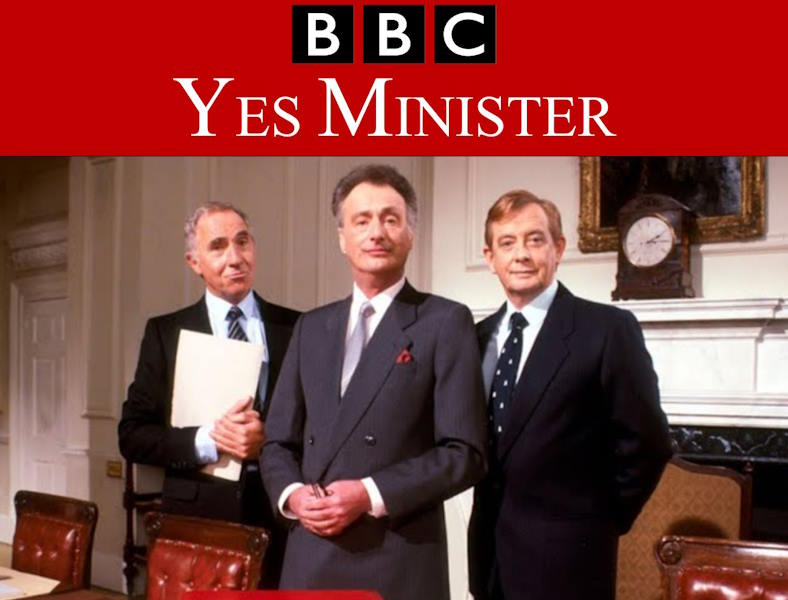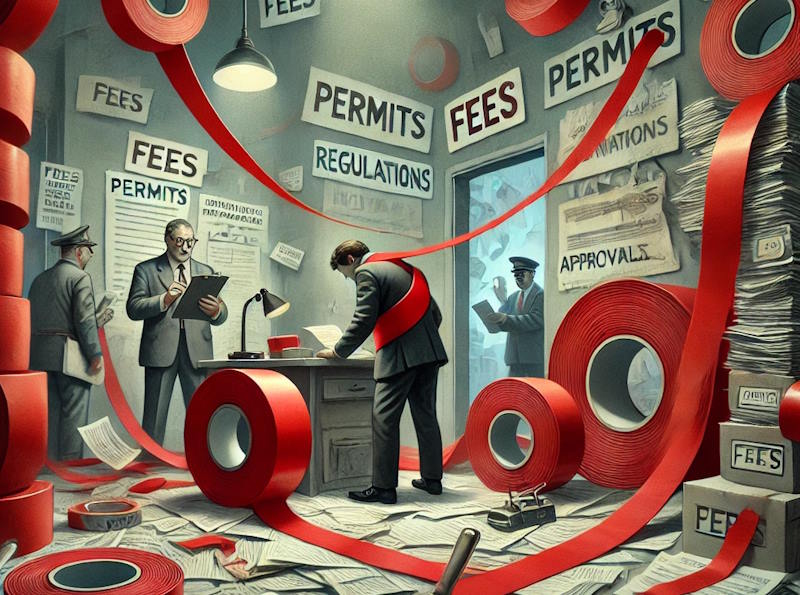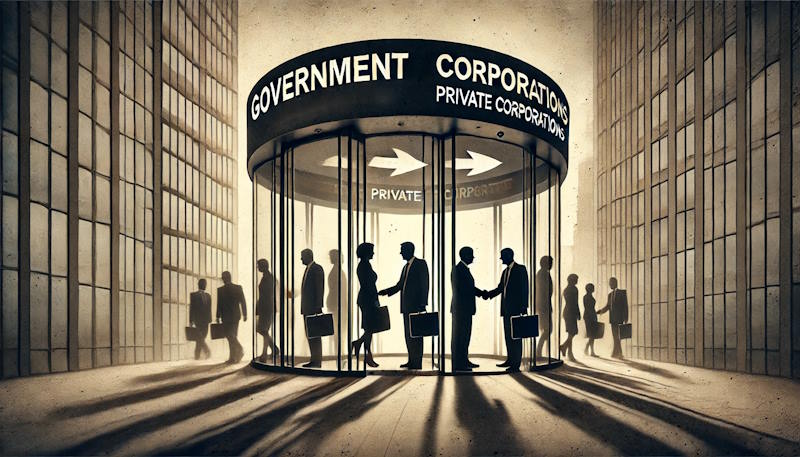Shadow Power: Civil Servants and Bureaucrat's Dominion Over Politicians:
Politicians are a performance, a spectacle designed to give the public the illusion of control. Elections come and go, manifestos are paraded, promises made and broken. Yet behind this thin veneer of democracy lies the cold, unyielding reality: politicians do not rule. They do not truly govern. That power lies elsewhere, embedded deep within the bureaucratic machinery—the civil servants and bureaucrats who quietly, ruthlessly, and methodically run the world.

The Case Study of Yes Minister: See Video
If ever there were a fictional masterpiece that exposed this stark reality, it is the BBC’s Yes Minister. Through the cunning and manipulative Sir Humphrey Appleby, we see the archetype of the career bureaucrat—brilliant, experienced, and entirely self-serving—guiding, undermining, and controlling the hapless Minister James Hacker.
Sir Humphrey’s tactics are a textbook example of bureaucratic dominance:
• Manipulation of Information: Sir Humphrey often bombards Hacker with complex jargon or deliberately obfuscates facts to steer decisions in the direction he prefers.
• Delaying Tactics: Reforms proposed by Hacker are frequently stalled with endless committees, studies, and feasibility reports that go nowhere.
• Subversion of Authority: Sir Humphrey's primary loyalty is to the bureaucracy itself, not the minister or even the government of the day. His primary aim is to maintain the status quo and protect the interests of his department.
The brilliance of Yes Minister lies in its humour, but the humour masks a chilling truth: civil servants like Sir Humphrey are not just fictional. They are real, and they are everywhere. The show may have aired decades ago, but its lessons remain painfully relevant
Why Bureaucrats Rule:
The reasons for this dominance are as plain as they are infuriating. Bureaucrats are permanent; politicians are temporary. Politicians are transient figures, flitting through the corridors of power for four or five years at a time before being unceremoniously replaced. Bureaucrats, on the other hand, are the bedrock upon which governments rest. They are not accountable to the public, not dependent on votes, and rarely subjected to meaningful scrutiny.
Civil servants operate with a quiet smugness, knowing full well that politicians depend on their expertise. After all, who drafts the policies? Who ensures they are implemented? Who interprets the laws? Politicians may sign the documents, but the bureaucrats decide what those documents mean, how they will be enforced, and whether they will be enforced at all.
How Bureaucrats Exercise Power:
Let us not be naïve. Bureaucrats are not neutral, impartial servants of the public good. They are masters of subtle manipulation, wielding power through methods that politicians scarcely understand:
1. Policy Gatekeeping: Bureaucrats are the architects of policy, deciding what is feasible and what is not long before a politician even gets to propose it. By framing the options, they control the outcomes.
2. Selective Information: Bureaucrats are the custodians of knowledge within governments. They control what information reaches politicians and how it is presented, shaping decisions from behind the scenes. When a minister is misinformed, it is rarely an accident.
3. The Weapon of Delay: Nothing kills reform faster than bureaucracy. A civil servant does not need to openly defy a politician; they simply need to slow down. Delay is the most effective weapon in the bureaucrat’s arsenal, allowing them to outlast even the most persistent of politicians.
4. Institutional Self-Interest: Bureaucrats serve institutions first, not people. Their primary goal is to protect their departments, their budgets, and their careers. If the needs of the public or the directives of politicians interfere, they are quietly sidelined.
5. Regulatory Obfuscation: Bureaucrats excel at creating labyrinthine regulations so complex that even the most determined politician cannot navigate them. This ensures that the power remains firmly in the hands of those who understand the system—themselves.

The Tyranny of "Red Tape"
Perhaps the most visible and infuriating manifestation of bureaucratic power is red tape—a term that has become synonymous with the layers of permits, policies, regulations, and administrative hurdles that bureaucrats use to dominate every facet of governance and daily life. Under the guise of regulation and order, red tape is a system designed not only to enforce control but also to expand the reach of the bureaucracy itself.
Methods of Exercising Power Through Red Tape:
Permits and Licensing: Bureaucrats impose an endless stream of permits and licenses for businesses, property, trade, and even personal activities. Want to open a small business? You’ll need permits for zoning, health, safety, environmental compliance, signage, and more. Each step introduces another bureaucratic gatekeeper, another delay, another fee.
- Planning Requirements: The planning process is a labyrinth designed to frustrate and intimidate. A simple construction project can be buried under demands for environmental impact assessments, public consultations, heritage preservation reviews, and a parade of other requirements. By the time approval is granted—if it ever is—the costs and delays have often rendered the project unviable.
- Regulations Upon Regulations: Red tape is never static; it grows. Bureaucrats constantly create new rules, often overlapping or contradicting existing ones, ensuring that no one can navigate the system without their guidance. This complexity consolidates their indispensability.
- Endless Reporting: Businesses, charities, and public organizations are crushed under the weight of bureaucratic reporting requirements. From tax filings to workplace safety logs, the paperwork is endless and designed to entrap. Miss a deadline or a detail, and the consequences are swift and severe.
- Unclear Criteria: Bureaucrats excel at creating vague, subjective, and often contradictory regulations. By keeping the rules ambiguous, they grant themselves maximum discretion. Businesses and citizens are left guessing at what is required, making them more dependent on bureaucratic approval.
- Inspections and Compliance Checks: The specter of bureaucratic inspections looms large over industries. Inspectors wield immense power, often demanding arbitrary changes or imposing fines with little accountability. Even when businesses comply, the goalposts can shift, keeping them perpetually at the mercy of the bureaucracy.
- Multiple Overlapping Agencies: Bureaucrats use the tactic of jurisdictional overlap to create confusion and delay. One agency may approve a project only for another to reject it. Each claims authority, and none takes responsibility, leaving citizens trapped in an administrative tug-of-war.
- Policy Micromanagement: Bureaucrats often bypass politicians entirely by embedding their preferences into the fine print of regulations. These rules are rarely debated publicly and are often enforced without political oversight, granting bureaucrats unchecked authority.
- Fee Structures and Hidden Costs: Red tape is not just a tool of control; it is also a revenue stream. Bureaucrats impose fees, surcharges, and penalties at every stage of the process, draining resources from citizens and businesses while enriching the bureaucracy.
- Artificial Scarcity of Approvals: Bureaucrats often ration permits and licenses, creating artificial scarcity. This scarcity allows them to wield power over applicants, rewarding those who comply with their demands and punishing those who resist.
The Consequences of Red Tape:
Economic Paralysis: Red tape strangles innovation and enterprise, discouraging investment and growth. Small businesses are particularly vulnerable, often unable to navigate the bureaucratic maze without significant cost.
- Disempowerment of Citizens: Red tape alienates citizens from their own government, making them feel powerless and subservient.
- Institutional Expansion: The creation of red tape often justifies the expansion of bureaucracy itself. More regulations require more administrators, more inspectors, and more oversight committees, perpetuating the cycle.
Red tape is not merely a byproduct of governance; it is a deliberate strategy. Bureaucrats use it to consolidate their power, entrench their authority, and ensure that nothing significant can happen without their approval. It is both a symptom and a tool of bureaucratic dominance.

The Revolving Door:
Bureaucrats’ Most Brazen Betrayal:
If the subtle manipulations and structural dominance of bureaucrats were not enough, there is another, more insidious mechanism by which they extend their influence: the revolving door. This term refers to the alarming trend of civil servants and bureaucrats moving seamlessly between public office and high-paying roles in private corporations—often within the very industries they were once tasked with regulating.
This practice creates an obvious and devastating conflict of interest. When a bureaucrat knows they can secure a lucrative position in the private sector after leaving public office, their loyalties are no longer to the public. Instead, they align themselves with the interests of the industries they regulate.
The consequences of this revolving door are far-reaching and destructive:
1. Regulatory Capture: The revolving door allows industries to “capture” their regulators, ensuring that policies and enforcement favour corporate interests over public welfare. This is not governance; it is corruption in all but name.
2. Soft Oversight: Civil servants with their eye on a private sector job are unlikely to impose stringent regulations or penalties on the companies they hope to work for. Instead, they act as enablers, weakening oversight and enforcement.
3. Policy Design for Profit: Bureaucrats who intend to join private industry often shape policies that benefit their future employers, embedding corporate interests into the very framework of government.
4. Public Distrust: The revolving door destroys public trust in government. How can citizens believe in the integrity of their institutions when regulators routinely join the industries they were supposed to keep in check?
Real-World Examples:
From pharmaceutical regulators who join drug companies to defence officials who move into arms manufacturing, the revolving door is ubiquitous. The financial sector is particularly infamous for this practice. Time and again, banking regulators have left public office to take up positions in the very institutions they were meant to regulate. The 2008 financial crisis revealed the devastating consequences of this cozy relationship, as regulators turned a blind eye to reckless behavior in exchange for personal gain.
What Enables Bureaucratic Dominance:
The bureaucratic stranglehold on governance thrives in the shadows. Civil servants are not subject to elections, and their names are rarely known to the public. Their decisions are hidden behind layers of impenetrable jargon, obscure protocols, and faceless committees. This anonymity is their greatest weapon, allowing them to evade accountability while exercising immense influence over the lives of millions.
When Bureaucrats Seized Control:
The seeds of bureaucratic dominance were sown during the rapid expansion of government in the 19th and 20th centuries. As governments grew larger and more complex, the need for specialized expertise created a new class of administrators—unelected, permanent, and indispensable. Over time, these administrators consolidated their power, gradually transforming themselves into the true rulers of the state.
Today, bureaucratic dominance has reached its zenith. In every major nation, civil servants wield more power than the elected officials they supposedly serve. This is not democracy; it is bureaucratic oligarchy.
Where Bureaucrats Thrive:
This phenomenon is not confined to one country or region; it is a global epidemic. From the European Union’s technocratic elite to the United States’ sprawling federal agencies, bureaucrats dominate every level of governance. They are most entrenched in nations with large welfare states, extensive regulatory regimes, and weak political accountability.
A Warning to Politicians:
Politicians, you are being played. You may believe you are in control, that your titles and mandates mean something. They do not. You are marionettes, and the strings are pulled by the faceless mandarins in your departments. They control the flow of information you receive. They dictate what is possible and what is not. They know how to outlast you, how to delay your reforms, how to turn your ambitions into meaningless words on a forgotten piece of paper.
Here is the bitter truth: the bureaucratic machine does not serve you. It tolerates you. It endures you because it knows you are temporary. Your tenure is a moment; theirs is a lifetime. If you do not assert control—real control—you will leave office with little to show for your efforts.
Stop being complacent. Stop trusting the civil service to act in good faith. If you want to govern, you must take the fight to the bureaucrats. Challenge them. Demand transparency. Cut through their red tape. If you fail to do this, history will remember you not as a leader but as a pawn.
A Warning to Voters:
Voters, you are being deceived. You rail against politicians, blaming them for the failures of government. You watch them bicker in parliament, make promises they cannot keep, and stumble from one crisis to the next. And yet, the real power lies elsewhere, in the faceless bureaucracy that you neither see nor elect.
Do you think your vote matters? Do you think it changes anything? The bureaucrats laugh at your naivety. They know that politicians come and go, but their power remains untouched. They are not accountable to you. They are not accountable to anyone.
If you want change—real change—you must look beyond the ballot box. Demand accountability from the bureaucrats who wield unchecked power. Insist on transparency in the civil service. Hold not just politicians but the entire machinery of government to account. Otherwise, you are not citizens of a democracy. You are subjects of a bureaucracy.
The Foundation of Civil Service Power:
A well-run country relies heavily on a well-functioning Civil Service. Operating under a code of conduct designed to uphold public trust, civil servants are guided by core values such as integrity, honesty, objectivity, impartiality, and political impartiality. These principles, though noble in theory, often serve as both a foundation of power and a smokescreen for unaccountable influence.
Core Values as Tools of Power:
Integrity: Civil servants are expected to put the obligations of public service above their personal interests. However, this principle can often manifest as a calculated effort to protect institutional priorities over the needs of the public, ensuring the bureaucracy remains untouchable. See Code
- Honesty: The Civil Service is tasked with being truthful and open, yet information is frequently filtered, withheld, or manipulated to suit bureaucratic objectives, keeping politicians and the public in the dark.
- Objectivity: Decisions are ostensibly based on rigorous evidence analysis, but the selection and presentation of that evidence are controlled by the bureaucracy, effectively determining outcomes long before they reach elected officials.
- Impartiality: Civil servants must serve governments of all political persuasions equally. In practice, this often translates to passive resistance to political agendas that challenge the status quo of the Civil Service itself.
- Political Impartiality: Civil servants are legally required to avoid politically partisan actions. However, their decisions and actions can quietly favor certain policies or ideologies, steering governance in subtle but powerful ways.
- Rights and Responsibilities: The Civil Service Code also defines the rights of civil servants, including protections against undue political pressure, which further insulates them from accountability while empowering them to act autonomously.
Conclusion not a neutral force:
In reality the civil service is not a neutral force. It is not a servant of the people. It is an unelected, unaccountable behemoth that quietly governs the world while politicians and voters remain distracted by the spectacle of democracy.
This is not a conspiracy theory;
it is a reality hidden in plain sight. Bureaucrats are the true rulers of the world. They are the ones who shape policy, control its implementation, and determine its outcomes. If politicians and voters do not wake up to this fact, they will remain prisoners of a system they neither understand nor control. The alternative is to accept the rule of bureaucratic oligarchy and watch as accountability, transparency, and representation become relics of a bygone era.


